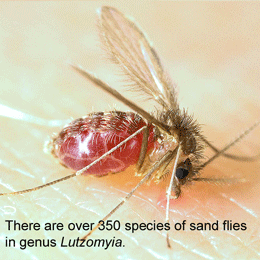Leishmaniasis is a chronic parasitic infection caused by various Leishmania species, kinetoplast protozoans related to Trypanosoma (the latter includes agents of African sleeping sickness and Chagas disease, suggested as a cause of Charles Darwin’s ill health in late life). Depending on the species involved, leishmaniasis manifests as illness ranging from non-healing cutaneous or mouth ulcers (CL) to sometimes fatal visceral infection (VL). In the Neotropics, 12 species infecting humans have been identified, all associated with CL. Neotropical leishmaniasis is mostly zoonotic (ie originates from animal reservoirs as opposed to human-to-human transmission), and the vectors are tiny phlebotomine sand flies, particularly Lutzomyia sp.
 In March 2010 PloS Neglected Trop Diseases investigators from Smithsonian Tropical Research Institute (STRI) and Instituto Conmemorativo Gorgas de Estúdios para la Salud, Panamá, apply DNA testing to Lutzomyia sandflies collected on Barro Colorado Island, STRI’s island home in the Panama Canal. Aiming to analyze as many species as possible, Azpurua and colleagues selected 435 individuals, which they morphologically identified as representing 16 Lutzomyia and 2 Brumptomyia sandfly species, for further analysis. Over 95% of specimens in the original collection were from one species, L. panamensis, so this was not a completely representative sample; nonetheless, “the relative abundances of species collected in this study were significantly correlated to those found in a previous intensive study of sand fly community composition on the [Panama] mainland…that collected over 30,000 Lutzomyia individuals in 35 species.”
In March 2010 PloS Neglected Trop Diseases investigators from Smithsonian Tropical Research Institute (STRI) and Instituto Conmemorativo Gorgas de Estúdios para la Salud, Panamá, apply DNA testing to Lutzomyia sandflies collected on Barro Colorado Island, STRI’s island home in the Panama Canal. Aiming to analyze as many species as possible, Azpurua and colleagues selected 435 individuals, which they morphologically identified as representing 16 Lutzomyia and 2 Brumptomyia sandfly species, for further analysis. Over 95% of specimens in the original collection were from one species, L. panamensis, so this was not a completely representative sample; nonetheless, “the relative abundances of species collected in this study were significantly correlated to those found in a previous intensive study of sand fly community composition on the [Panama] mainland…that collected over 30,000 Lutzomyia individuals in 35 species.”
To skip to the end, COI barcodes unambiguously assigned all 49 individuals to 18 distinct lineages corresponding to named species, plus highlighted 2 genetically-divergent individuals that might represent cryptic species. Using primers for ITS-1 (a nuclear gene) and mini-circle DNA (part of mitochondrial genome), Leishmania were detected in 2 of 5 human-biting species, Lu. trapidoi (13/30 individuals tested, 43.3%) and Lu. gomezi (5/19 individuals tested, 26.3%). By my estimate, taking into account relative abundances of Lutzomyia sp., about 1% of Barro Colorado Island sand flies carry Leishmania. Surprisingly, DNA sequencing identified the parasite as Le. naiffi, a South American species not previously reported in Panama. Finally, using the same set of DNA extracts, the researchers tested for Wolbachia, a rickettsial intracellular insect parasite and candidate biological control agent. Wolbachia were found in 3 of 18 species, including 50% of Lu. trapidoi, the main vector of CL in Panama. As an aside, I note that the presence of Wolbachia apparently did not interfere with discriminating among sand fly species; hypothesized interference from Wolbachia was one of the early worries some expressed about DNA barcoding (e.g Whitworth Proc Biol Sci 2007).
Standardized DNA testing enables many more persons to identify insects, regardless of life stage, including those that serve as vectors for human diseases. In this report by Azpurua and colleagues, the discovery of a new species of Leishmania for Panama, and possible undescribed Lutzomyia vectors, suggests that wide application of standardized DNA testing will lead to further discoveries relevant to control of human and animal infectious diseases.